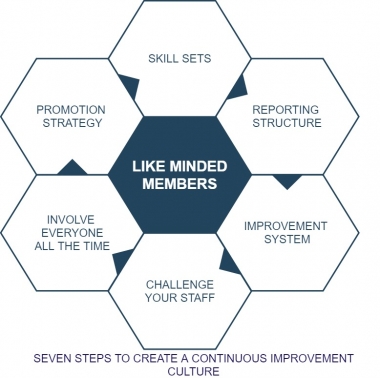Have you ever wondered why it is difficult to get your organisation to accept new ideas while others readily accept them?
This article relates a real example of how a continuous improvement culture started.
1. Why are some organisations more accepting to change than others?
The other day, I was having lunch with a friend, and we started talking about different organisations and their improvement programs. I related my experience with an organisation I had engaged with in implementing their continuous improvement program. I was so excited sharing about the changes until he interrupted me with the following comment “sounds like the organisation you worked with was more accepting to change than ours”.
What my friend said was true, and that got me thinking.
Comparing my previous workplace and my friend’s current challenges, I found it easier to implement new ideas at my last workplace. The people in the last organisation were more willing to try new things do something out of the ordinary. Instead of focusing on what couldn’t work, they focused their energy on what they could do to make it work.
When I look back, I realise it didn’t start that way. We started like any other organisation.
When the previous company I worked for started to embrace a transformation program four years earlier, we got the same resistance:
“In an ideal situation, why fix things when nothing’s broken”;
“We are short of resources”;
“It will work, but not for us”;
“We have tried it before” and many more reasons.
We initiated the program in any case. We started with a massive launch party going all out with the usual celebratory fanfare, from balloons to catering a feast for the masses. We began to form teams, have regular meetings and implement some ideas despite some reluctance. At this stage, everyone in the company watched to see how things would pan out and how it would fail (again) as it had many other times.
We achieved what we believed to be some success in the immediate. However, not long after, these successes subsided. The meetings became less frequent, changes were not sustainable, and people went back to the old established ways.
2. Hang on tight.
In hindsight, we did right that we kept the transformation flame aglow, even though it was a dying ember. We sent out information, kept knocking at the doors of different departments, and continued to market any success stories no matter how small the win was.
Eventually, on that fateful day, we hit a massive improvement. We reduced an operational process from fourteen days to one day, speeding up processes downstream reducing our overall lead time.
This success was an eye-opener for everyone. What we thought was not possible before now was measurable, quantified and qualified. Everyone became highly excited and motivated.
To cut a long story short, when these people had seen and felt success, their outlook about the transformation program changed. They more readily accepted unconventional ideas and were open to taking greater risks in trying new things. The next time someone has an idea, it is looked at from a more positive and enthusiastic perspective. This company continues to improve up until today.
If you are starting with your continual improvement program and experiencing resistance, all is not lost. Resistance is only natural and doesn’t mean that people are against you. They have not seen the other side of things yet. It is like telling someone the orange you are eating is sweet. They won’t believe you until they have tasted it.
So, if you are looking to build a culture of continuous improvement and promote acceptance of change, you must keep knocking and chipping away at the edges, bit by bit. You do that relentlessly. Eventually, the message will get across, and people will accept change.
3. The seven steps.
Here are some suggestions for what you can do to create a culture of continuous improvement in your organisation.
- Predefine your overall continual improvement program and keep up with the activities. Avoid allowing for slack, even though progress is slow.
- Have a reporting structure with a fixed timeline. Keep everyone posted on your progress.
- Promote success stories via internal emails or videos.
- Regularly meeting up with like-minded personnel in your organisation will keep the flame aglow.
- Identify and fill in any gaps in the skills set. Attend training and or ensure the team are trained. Visit other organisations to get insights.
- Be an example. In your daily work, challenge yourself to do things differently. Challenge others to try new solutions whenever possible.
- Don’t leave out senior management. Get them involved in any appropriate way. It can be simple to attend your team meetings or give out movie tickets for winning ideas.
I trust you find encouragement in knowing that it is possible to create a culture that accepts change, but it always has to start somewhere.
All the best with your endeavour.
K Y Loke

